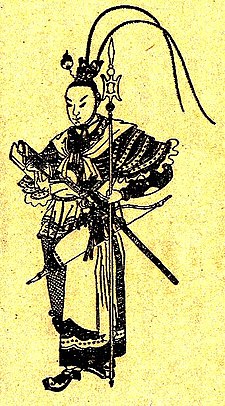 Who doesn't like some déshabillé period costume ?
Who doesn't like some déshabillé period costume ?REVISIONIST JAPANESE HISTORY, JERRY SPRINGER STYLE.
Maybe that makes the book sound unpalatable to some readers, but believe me when I say that this is not "so horrible it's good." It's so good it's horrifying. At least, enough people thought so that the work won a Kondansha Manga Award in 1983.
First, the art: Yamagishi Ryouko is famed as one of the pioneering female mangaka who jump-started the shoujo manga or "girls' comics" movement--the so-called "Year-24 Group" (二十四年組), or "Forty-niners," who were born in 1949 and were among the first women to enter the Japanese comics-making world. Most of this group's work would thus be considered rather old-school by the aesthetic terms of modern manga. Take this page from Kaze to ki no uta, by Yamagishi's fellow Year-24er Takemiya Keiko:
 Major characteristics of classic shoujo from authors in this generation include stylized, glamorous-looking protagonists, cartoony cariactures in the supporting cast, an unironic abundance of flowers, pointillist bubbles, and sparklies, and an earnest deployment of coventions such as vertical lines on the face, which denote shock and/or fear. No CG technology here, folks--all the toner and ink carefully hand-applied. Most of the lines are highly organic and finished, in contrast to some of today's authors, who may strive for a "rougher" or "simpler" look. On top of all this, Yamagishi demonstrated a decided fondness for period costume and, to a lesser extent, other material bits of history (her interiors never as dense as Takemiya's, nor her page layouts as complex and thickly packed). To wit, a page from Hi no izuru:
Major characteristics of classic shoujo from authors in this generation include stylized, glamorous-looking protagonists, cartoony cariactures in the supporting cast, an unironic abundance of flowers, pointillist bubbles, and sparklies, and an earnest deployment of coventions such as vertical lines on the face, which denote shock and/or fear. No CG technology here, folks--all the toner and ink carefully hand-applied. Most of the lines are highly organic and finished, in contrast to some of today's authors, who may strive for a "rougher" or "simpler" look. On top of all this, Yamagishi demonstrated a decided fondness for period costume and, to a lesser extent, other material bits of history (her interiors never as dense as Takemiya's, nor her page layouts as complex and thickly packed). To wit, a page from Hi no izuru: Now that the aesthetic context is gotten out of the way, onto the juicy part. The story concerns the exploits of young Prince Shoutoku [CE 574-622], known also as Prince Umayado [厩戸]. As most know him, Shoutoku was a promulgator of Chinese culture--Buddhism and Confucian values*--as exemplified in his patronage of temples: Shitennoji, and the magnificent Houryuuji. The "Seventeen-Article Constitution" that Wikipedia so helpfully calls "one of the earliest moral dictatorial documents in history" is generally attributed to him, as well. In case you, hypothetical reader, cares, the moral injunctions were mostly pretty "duh": obeying imperial commands, not rushing to decisions by one's lonesome, etc. Awesomely, until the 1890 Meiji constitution came into effect, this document was completely valid. Even today, the Japanese constitution does not technically override it.*
Now that the aesthetic context is gotten out of the way, onto the juicy part. The story concerns the exploits of young Prince Shoutoku [CE 574-622], known also as Prince Umayado [厩戸]. As most know him, Shoutoku was a promulgator of Chinese culture--Buddhism and Confucian values*--as exemplified in his patronage of temples: Shitennoji, and the magnificent Houryuuji. The "Seventeen-Article Constitution" that Wikipedia so helpfully calls "one of the earliest moral dictatorial documents in history" is generally attributed to him, as well. In case you, hypothetical reader, cares, the moral injunctions were mostly pretty "duh": obeying imperial commands, not rushing to decisions by one's lonesome, etc. Awesomely, until the 1890 Meiji constitution came into effect, this document was completely valid. Even today, the Japanese constitution does not technically override it.*Anyway, Shou-chan is a very respected figure, indeed almost a saintly one, though apparently some have disputed his existence (not to mention the attributions of various things to him). Even so, he was on Japanese currency until 1984:
Now, go and look at that pretty picture at the beginning again. Yep. Yamagishi intended it to be the same man. The flowers+hair loops visualization has apparently stuck; here's a cover from Ikeda Ryoko's Prince Shoutoku manga, which was published about a decade later [you betcha there have been some debates about Ikeda plagiarizing from Yamagishi]:
Anyway, here we've got a most
-Countless plots to horribly murder various important people, quite a few of which succeed
-Actual incest [which, by the way, the reader sees from a mile away but is like unto a runaway locomotive in its relentless momentum], consummated via deceitful trickery
-Illegitimate children who represent about 80% of the births in the book, the most plot-central of which result from suspiciously endogamous sex
-Nonconsensual sexual acts
-Dream [GHEI] sex
-General homoerotics, riddled with more angst and Unresolved Sexual Tension than a gay Harry Potter "deathfic" and all kinds of gender issues
-Issues of which are mostly manifest in Shoutoku's repeated and highly successful cross-dressing
-Suicidal thoughts and attempts so far up the frigging wazoo that it's probably come out on the other end
-Trippy-as-hell and very distressing dreams, visions, out-of-body experiences, ESP, telekinesis, telepathy...Shoutoku will kill you with his mind
In this delightful melting-pot of freakishness, Yamagishi mixed a beautiful, cold, traumatized Prince Umayado, his [very obvious] love interest Soga no Emishi, various historically recorded folks from the Soga clan, the imperial line, and what feels like everywhere else. The thing is over two thousand pages long, so here I'll just discuss why I think this particular bit of revision is so engrossing quickly.
1. Yamagishi plotted her political and romantic intrigues with great mastery: gripping, intense, but not quite so over the top that one lost a deep engagement with the story. Mostly, she achieved this by plumbing the vast casts' psychologies with consistent dexterity. Emishi isn't just a stupid 6th-century frat boy, though that could have been his lot. His ultimate rejection of Umayado is so devastating because the reader believes that, for one, it might not have been that way "if only...", and for another, Yamagishi gives us so much insight into the human torments of the characters that we feel all the proper mono-no-aware catharsis.
2. The art feels sometimes archaic and a little stiff, but there's something about classic manga's willingness to conventialize and stylize that reveals the medium's parity to other highly formulaic yet nonetheless engaging visual genera, i.e. noh or Peking opera. It's a little silly when Umayado can't seem to put his hand on anything without making it look as delicate as possible, but then again, arguably that's part of manga's heritage from more traditional Japanese art. Where she needs it, Yamagishi makes use of the image's power to "tell all."
In short, the images and words together convey an immense, realistically textured emotional universe for not just the protagonists, but all the major characters. There are not too many absolutes in Yamagishi's world. Just about everyone is capable of making the reader groan in frustration, recoil in horror, or smile.
3. Also importantly, the manga isn't shy about its facts. The machinations of Soga no Umako, Emishi's doggedly conventional father, and virtually all of the characters, are situated with what was a surely considerable amount of research. The politics of 6th-century Japan are not just about sleeping with sisters and cross-dressing to impress, but related to international history: the Paekche-Koguryo-Silla standoff on the Korean peninsula, for instance, is of great import to the cast--and even if the reader didn't have any clue about the situation, its immediacy in the story. On the mainland, the Sui dynasty exterminates the Chen and unites a huge swathe of formerly divided territory. And, of course, the title takes its title from the famous missive Shoutoku wrote to the Sui emperor in 607: "From the ruler of the land of the rising sun, to the ruler of the land of the setting sun, greetings...."
To draw hundred of pages in quest of the legendary creature who wrote those haughty words and coined the phrase "Nihon" is impressive enough, but to give these long-dead folks, often without much more than a name, the dimensionality of people trying to cope with their situations, their emotions, their pasts, is truly the most admirable point of good history as well as good historical fiction. Sometimes the boundary isn't so clear, and verification almost seems unimportant. Yamagishi's Shoutoku, with his angelically beautiful androgyny, a boy by turns cruel, vulnerable, brilliant, loveable, domineering, and passionate, is nothing like the moralizing gentleman with a respectable beard whose portrait is printed in history books. But his divergence from that man fails to signify after we pass through the landscape that Yamagishi drew for him. That's the sign of the best kind of historifandom: with enough power that it can stand alongside what is conventionally accepted as "reality," in a strange and attractive symbiosis.
Basically, if you have time to spare and would like to spend it marathoning through an epic of some kind, Hi no izuru is an excellent choice. Have another nice thing to look at, to whet your appetite:

**Oh Wikipedia, educational as always.






























.jpg)




